TRCA Actions
December 2020: Monitoring of gypsy moth egg masses in targeted Conservation Areas is underway. Toronto and Region Conservation Authority (TRCA) is also developing a Strategic Approach for the gypsy moth that will be posted soon.
The European gypsy moth (Lymantria dispar dispar) is a non-native moth species that can cause defoliation of trees in Ontario and Eastern North America.
The caterpillars will eat the leaves of more than 400 species of plants. They prefer oak, but will also eat other hardwood trees such as sugar maple, spruce, elm, birch and poplar.
They also feed on garden shrubs, flowering plants, and coniferous trees.
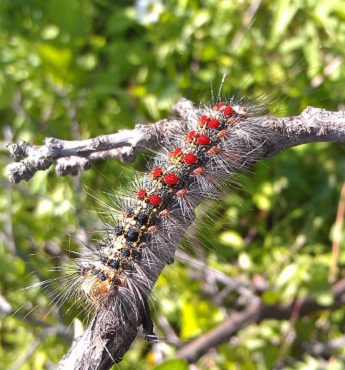
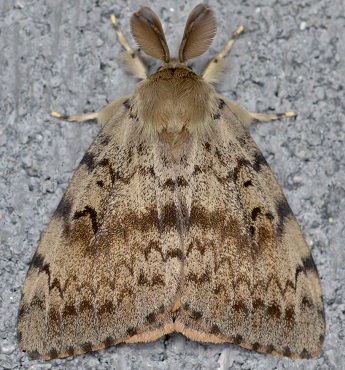
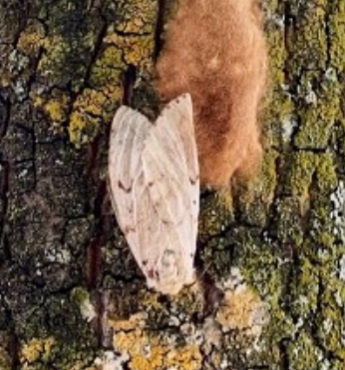
IMAGES: Gypsy moth larval caterpillar stage; adult male (Photo by Ryan Hodnett – Own work, CC BY-SA 4.0, https://commons.wikimedia.org/w/index.php?curid=50965794); and adult female (Photo courtesy of City of London)
Gypsy moth outbreaks in Ontario are cyclical, occurring every five to ten years.
During severe population outbreaks, caterpillars can devastate trees and forests. A single gypsy moth caterpillar can consume one square meter of leaves in a season.
Several years of defoliation can cause tree mortality, especially when it occurs alongside other stressors such as droughts, forest tent caterpillar (Malacosoma disstria) outbreaks, and fungal pathogens, although most hardwood trees are able to survive up to three years of defoliation.
Gypsy moths do not typically eat the leaves (or needles) of coniferous trees such as white spruce unless they have run out of other leaves to eat. Unfortunately, coniferous trees may not survive a single bad year of gypsy moth infestation.
In addition to ecological impacts, such as compromised health of trees and changes to forest composition over time, there are also economic and social impacts of an outbreak, including the temporary loss of beautiful forest canopies and the cost of removing and replacing dead trees from areas and parks. Some people even have allergies to gypsy moth caterpillar hair.
TRCA is taking an Integrated Pest Management approach. This means that we are monitoring certain areas and evaluating management options, which may involve using a combination of techniques.
Given that gypsy moths are behaving like a native pest, and many other invasive species require management, TRCA is unlikely to undertake widespread management.
Instead, management actions will focus on the protection of important individual trees or groups of trees (such as shade trees within a manicured area of a conservation park).
TRCA will support its neighbours through information and education about management techniques, as described below. Please note that TRCA will not visit private properties to assess or treat pest infestations. Property owners should contact tree service companies for assessment and other control options.
If you have a property at least 2 acres in size, you may qualify for subsidized tree planting under TRCA’s Private Land Planting Program, or if you have a forest at least 4 hectares in size, you may qualify for Forestry and MFTIP planning services. If you have a rural property you may qualify for the Rural Clean Water Program.
Contact us for more information: trees@trca.ca.
- Learn to identify the gypsy moth during its various life stages (see next section).
- Keep your trees healthy to minimize the impact of gypsy moth defoliation stress by ensuring your trees get enough water, and for individual trees or a woodlot conduct good forestry practices minimizing detriments to other forest values such as impacts to root zones and overall water quality.
- Report sightings to the toll-free Invading Species Hotline at 1-800-563-7711 or email info@invadingspecies.com. You can also submit information about your sighting at EDDMaps.org
- Practice the management techniques below.
MANAGEMENT OPTIONS FOR HOMEOWNERS*
| Activity | Timing | Notes |
| Hand Picking Caterpillars | May to July | Scrape off caterpillars into water/soap mixture, leave for a few days and then dispose in the garbage. Do not scrape caterpillars onto the ground. NOTE: Wear gloves since caterpillar hairs can cause skin irritation or allergies. |
| Burlap Banding | June to August | Place burlap band around truck where caterpillars will hide during the heat of the day. Check bands regularly and scrape caterpillars into a container with soapy water for a few days and dispose of in garbage. NOTE: Wear gloves since caterpillar hairs can cause skin irritation or allergies. |
| Pheromone Traps | July to August | Pheromone traps are intended to attract and trap male adult gypsy moths, to prevent them from mating with females. Generally, this is used as a monitoring technique but may reduce egg mass loading in small areas. Traps should be disposed of in the garbage. |
| Scraping Egg Masses | August to early May | Scrape off egg masses into soapy water, leave for a few days and dispose of in the garbage. Do not scrape egg masses onto the ground, this does not kill the eggs and may actually improve survival. NOTE: Wear gloves since caterpillar hairs can cause skin irritation or allergies. |
*These techniques are for protecting individual trees, and are not intended for large-scale management.
1. How to Identify the Gypsy Moth
- The gypsy moth has four life stages: egg, caterpillar, pupa, and moth.
- Caterpillars start off very small (about 2mm) and molt three to four times, growing larger each time. By the time they reach their last molt, caterpillars can be 5-6cm long. They are dark and hairy, with five blue and red dot pairs on the back.
- As adults, female moths are white with dark markings and cannot fly.
- Adult male moths are brown with dark markings and large feathery antennae, and can fly.
- Egg masses (shown below) are tan in colour, between the size of a dime and toonie and can be found on tree trunks, under bark, the outsides of buildings and cars, on patio furniture, on tents and trailers, etc.
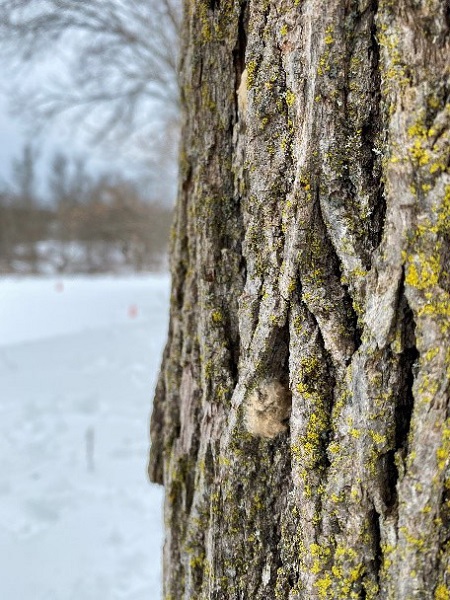
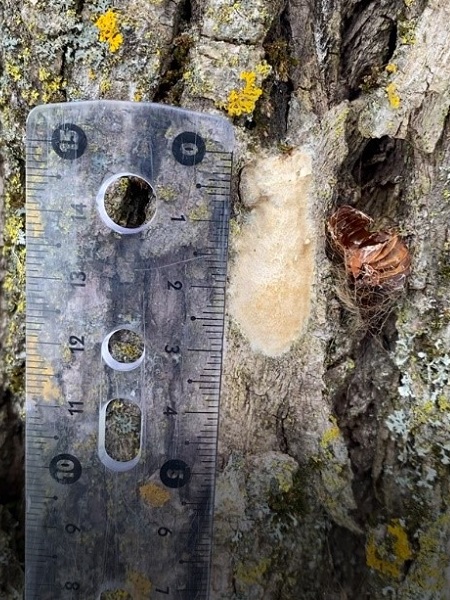
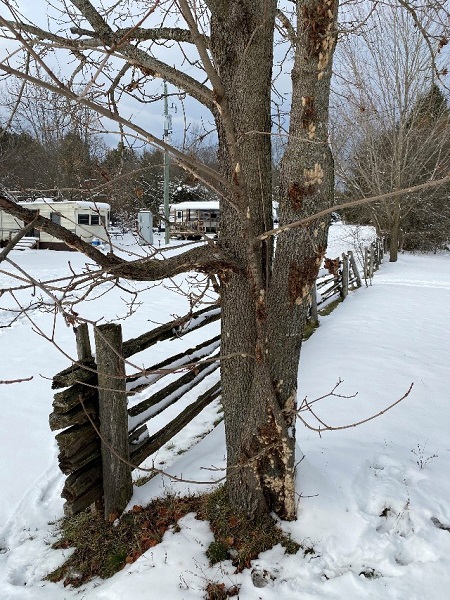
IMAGES: Gypsy moth egg masses (TRCA photos)
2. Gypsy Moth Life Cycle
- Egg masses hatch into caterpillars in the spring just as tree leaves begin to flush out. The caterpillars are tiny at this time and may not even be noticed. They can be carried by the wind for distances of up to 1km.
- Caterpillars are most active in May and June and their appetite grows as they get larger. Caterpillars typically eat at night and seek shelter during the heat of the day.
- Caterpillars become pupae in late June-early July and remain in this stage for 1-2 weeks.
- Adult moths emerge from the end of June through to August and live for about 2 weeks. They exist solely to reproduce; they do not eat. Only male moths can fly and during this time they pursue females by following the pheromone scent females produce.
- Females produce only one egg mass in their lifetime which can contain 100-1,000 eggs.
- Egg masses persist through the winter and ones that are buried by snow typically have higher survival as the snow protects them from temperature extremes.
Select life cycle image below to view a full-sized version of the chart.
3. What Makes This Invasive Species More Like a Native Pest?
The gypsy moth arrived in North America as a result of a misguided attempt to create a domestic silk industry. Its presence was met with alarm as the impact of defoliation became apparent.
Recent evidence, however, indicates that gypsy moths are behaving more like a native pest than an invasive species. This is due, in part, to the presence of several natural factors that help to regulate the population:
- The fungus Entomophaga maimaiga overwinters in soil and infects gypsy moths, resulting in their death. It needs cool, wet weather to persist and be effective.
- The nuclear polyhedrosis virus (NPV) infects caterpillars, causing them to climb to the top of the tree and die. The dead larvae become liquified, helping the virus to spread and infect other caterpillars. (It can also be spread through the feces of birds that eat dead or dying caterpillars.) The effectiveness of the virus is dependent on high caterpillar density — the more caterpillars there are per tree, the more likely that NPV can spread and effectively control populations.
- Prolonged extreme cold (below negative 26 degrees Celsius) coupled with a lack of snow can kill gypsy moth eggs.
- Natural predators including other insects, spiders, and several birds will eat gypsy moths in their various life stages — although this factor alone is unlikely to have significant population effects.
- Parasitoids (species that use others as hosts for their young) kill gypsy moths by feeding on their tissue. These species may play an important role in population control; however, this is not yet well understood.
- Host tree natural defences: as host trees are eaten by gypsy moths, they respond by growing tougher, less nutritious leaves making it more difficult for caterpillars to be successful.
- Competition between gypsy moths and ultimately starvation due to a lack of food will cause a collapse of gypsy moth populations, which is reflected by their typical cyclical outbreaks.
For more information on TRCA’s Gypsy Moth Strategic Approach, please contact:
Mark Funk
Senior Project Manager, Restoration and Resources Management
mark.funk@trca.ca

